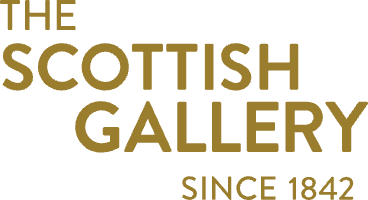The Michie Family
It is not uncommon for some artistic talent to pass onto the next generation and for a number of siblings and children to pursue a similar creative pathway. Anne Redpath is recognized as one of the greatest painters of her generation; her reputation grew beyond the confines of Scotland in her lifetime and continues to grow. Two of her sons, David and Alastair pursued careers in painting, although quite separately. They both used their own family name, Michie, that came from their father James who was an architect/peintre. For James Michie the burgeoning talent of his wife may have put a barrier in the way of a full flowering of his own ability, and for the Michie boys painting was not a family business (in the sense of the Renaissance family atelier) but two individuals combining natural talents with a steely determination to pursue their own star.
– Guy Peploe


David Michie (1928-2015)
The youngest of the Michie boys, David was born in St. Raphael in 1928. David’s first years immersed in the light and sun soaked landscape of the South of France were to have a lasting effect on him. Not only did it give him awareness of colour, but it gave him a taste for a life outside Scotland that was to inspire a love for travel he kept throughout his life. On returning to Hawick at the age of eight he was placed in a landscape of a different sort, but the vistas of the Lammermuirs, fields and woods around Hawick did not fascinate him in the same way they captured his mother. David’s gaze was more focused, enticed by the smaller aspects of the natural world; a dragon fly skimming across a pond’s surface.
The Andrew Grant Travel Scholarship


Michie studied at Edinburgh College of Art from 1947–53 under the painter, William Gillies. He was awarded the Andrew Grant travelling scholarship upon graduating, and travelled to Italy in 1953 with fellow painter and friend John Houston. This was to be the first time Houston had travelled abroad and can be viewed as a catalyst in two ways. It was his first taste of independence, when out of higher education; his art was purely determined by his own interest and self-discipline. It was also to engender a love of travelling which would last a lifetime.
They started out by way of Paris and then onto Milan and Florence, but it was the hill towns of Umbria and Latium which were to inspire Houston the most. They spent a snowy Christmas in Orvieto, after which Houston and Michie parted ways for a short while. Houston went on to Anticoli, a small village perched high up in the Abruzzo Mountains. His work from this time gives a clear impression of the conditions he found himself in. Houston relished the contrast between snow and earth; between the local architecture, formulaic vineyards and the undulating geography. Carefully structured and sympathetic records, the work from this period is as fresh and immediate as when they were created, 60 years on.

David Michie and I stayed in Florence for six weeks as there was a lot we wanted to see and many artists we both liked. From there we went to Siena, where we found the art more decorative; I liked the rather severe style of the early Italian artists. Of course, we were also expected to do some work. When we began to paint outside, the landscape was really quite pretty; it was the beginning of October and everything was still green. It wasn’t until Siena, when the time of year made the landscape appear stark, that it became more interesting for me.
John Houston in conversation with Philip Long, 2005
David’s lack of interest in conventional landscape painting led him to create a visual language completely unique. Not constricted by academic drawing, his compositions of flora and fauna are simplified in form and often float in an ambiguous space of flattened colour and pattern. The world that the artist describes is abundant and diverse and appeals directly to our senses. His figure subjects, (images often inspired by foreign travel) which can feature subjects as diverse as jazz musicians, skateboarders or fisherman, are all perfect snapshots of the bizarre natural drama of human experience.
David followed in his mother’s footsteps choosing to live in Edinburgh and become a prominent member of the second generation of The Edinburgh School, becoming Head of Drawing and Painting from 1982–90. Along with his friends and contemporaries Elizabeth Blackadder and John Houston, Michie’s contribution to Scottish painting is as an original image maker but also as a painter who believed in painting; a serious pursuit but one also which can give great pleasure.

Learn more about this exemplary artist in this film:
